Moving historical content here from the OS: (originally posted September, 2008 - in thread Repairing Front Axle Actuator, and theory of operation - Chevy TrailBlazer, TrailBlazer SS and GMC Envoy Forum)
The front axle actuator, that engages a splined disconnect when you go into A4WD, 4HI, or 4LO - is a reportedly high failure rate item. I don't carry a spare on the trails, but I've been considering it. My wheeling buddy Teebes has had intermittent problems with his 4WD system for many months, and rather than shotgun it at a dealer, I got him to be my guinea pig at finding the root cause and totally understanding the part.
He had previously swapped the actuator with a supposedly good new one, and also bought a user transfer case control module. One day, we swapped parts back and forth with my vehicle, but never found the root cause. The symptom was that the actuator looked like it worked fine outside the vehicle, but got flaky when installed. Looked like an electrical problem, so we concentrated on tracing wiring with the factory service manual for reference for a day. That eliminated the wiring, but didn't find the real cause.
The actuator is basically a severely geared down permanent magnet motor that drives a probe into the front diff disconnect from the passenger side. Total in-out stroke is 0.8", and you can push in on the internal lever with 2-3 pounds force. Here's the actuator in place.
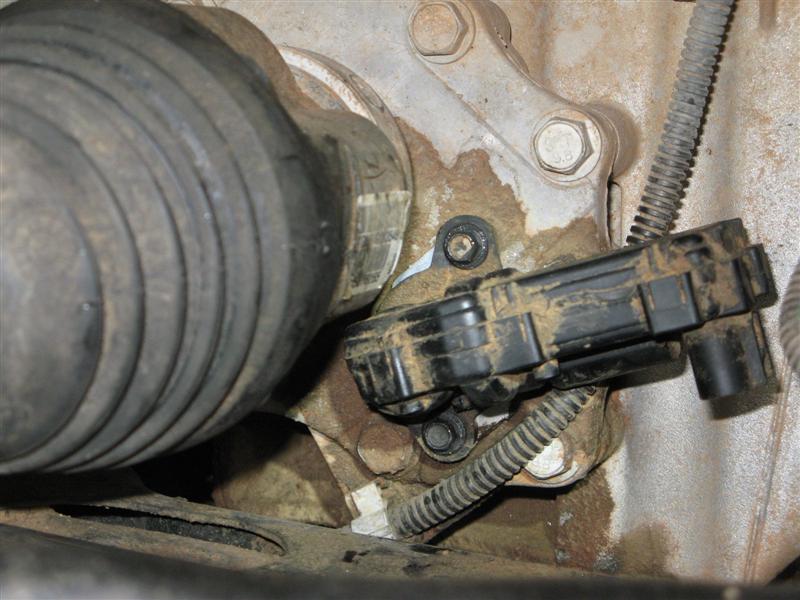
There's a 4-wire harness on the right side (not connected in the pic). It needs +12 and ground. The control signal from the TCCM goes high to command the actuator to extend its probe for 4WD, and goes low to command retraction for 2WD. There is a feedback signal that confirms to the TCCM that the actuator is working, and it sends a low for extended and a high for retracted. Upon first use, the TCCM senses the feedback signal, and if the actuator doesn't succeed in changing state when it's commanded to, the TCCM gives up, starts blinking one of the control switch LEDs, and (importantly) gives up. It won't try again until you turn the car's power off and reset the system. So if the actuator ever fails once to go to the position it's told to, the TCCM stops trying. It's not a serial data bus kind of module like the door switches or HVAC control box.
So what ended up happening for Teebes was that the actuator when it was installed, would attempt to go to the 4WD position, the motor would whine once, but it would stall out and never make it to the fully pushed-in position. By clipping taps onto the wiring harness, I could see the command line go high, the motor would move, but stop short of the fully-out position. The feedback wire would never go low, so the TCCM assumed the actuator had failed, and then it just gave up trying.
Removed from the vehicle, the actuator would whirr and go both ways, the feedback wire was correctly reporting its success, and the system worked fine. So it was obvious that the permanent magnet motor was stalling or the gears needed lubrication or something was binding.
The actuator's cover is stiff, and it's not easy to disengage the locking tabs as it is on a HVAC system mode/temp actuator, but if you break a couple or use toothpicks, you can get it off.
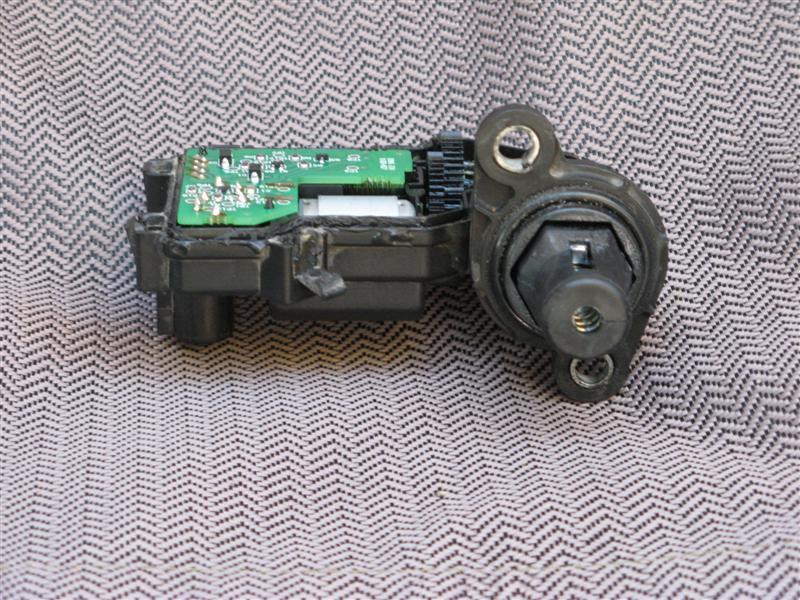
In this, you can see the motor, reduction gears, and a lead screw on the left that brings signals from the 4-pin connector.
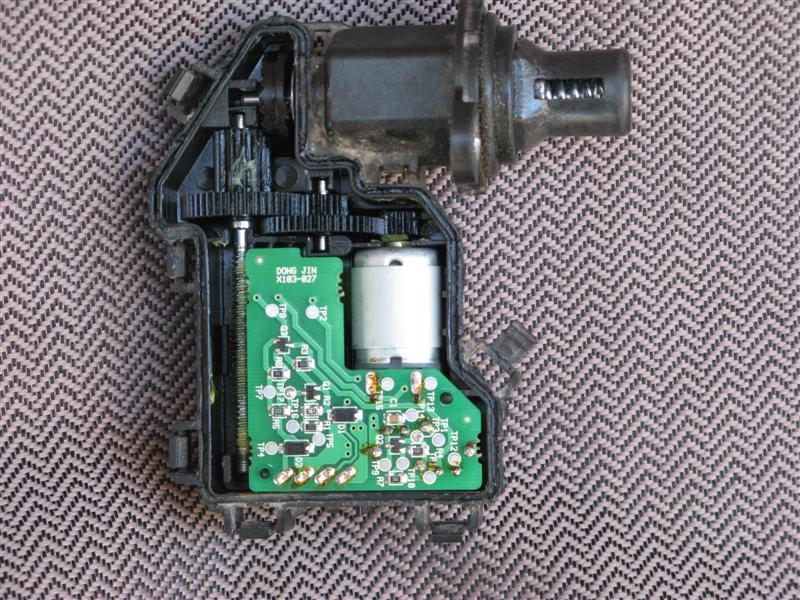
Empty housing.
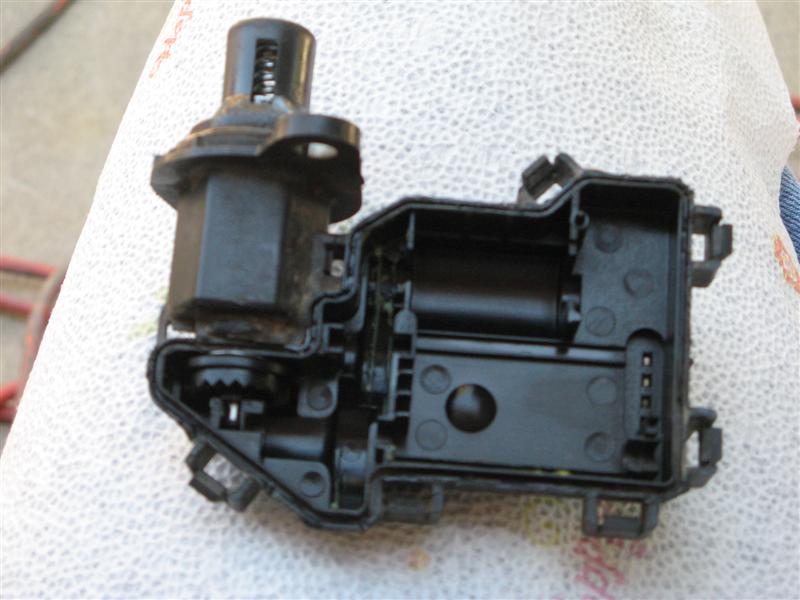
Sorry for the poor pic, but I'm really not going back to take this all apart to get better ones. This is the lead screw with four spring fingers that slide up and down on the bottom of the PC board.
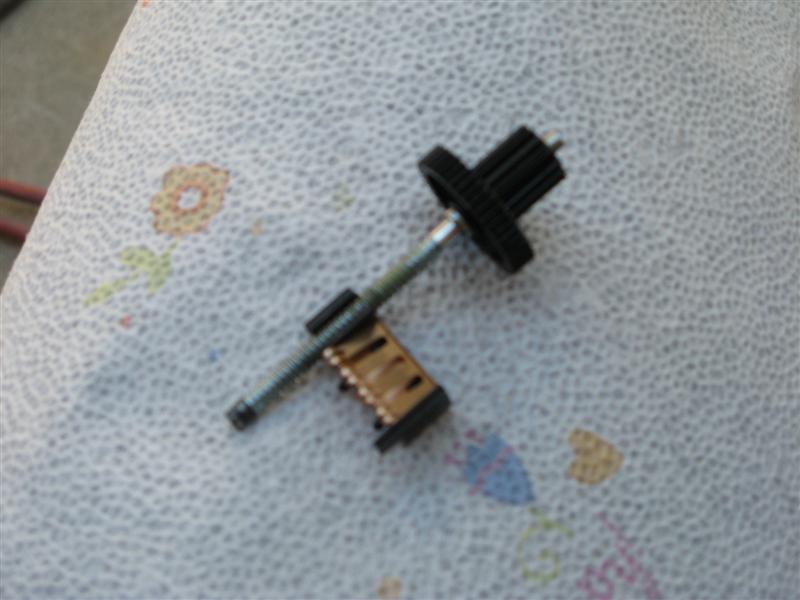
This is the PC board with the 4 stripes. The second from the top is the feedback signal, showing the break in the stripe where it goes from reporting high to low when extended. Note the actuator has to be near the end of the travel for this signal to change state, so if the motor stalls due to high load, like broken internals in the differential, it will fail to extend all the way, and the TCCM will see that and give up trying.
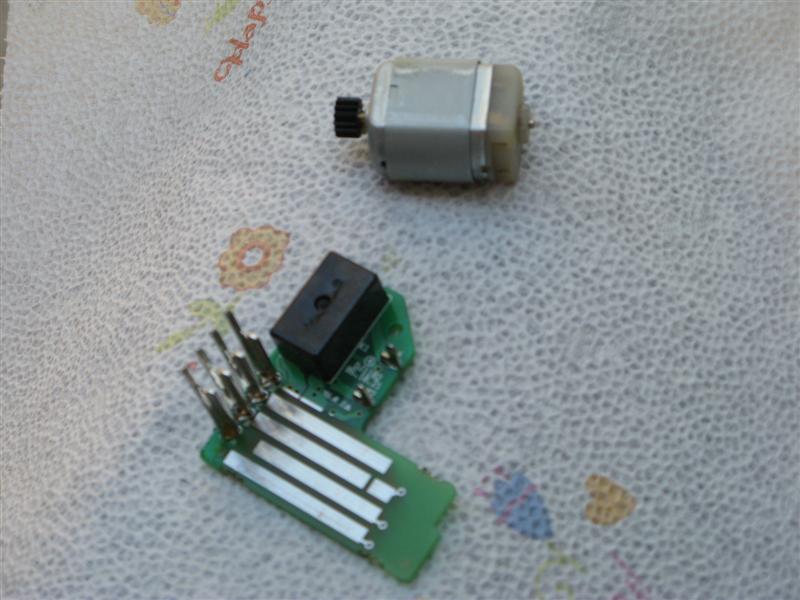
Taking it apart, I didn't feel any unusual binding in the gear train or the actuator probe, but there was obvious grease on the copper fingers and the PC board stripes. The mounting angle in the vehicle would tend to keep grease away from the fingers, but this unit was one Teebes bought as a replacement, so it had been on the shelf a few years perhaps. I'm guessing the box it was in had the PC stripes at the bottom and grease migrated over the years.
Grease caused a higher resistance than normal on the finger to PC stripe contact. The PM motor has to draw 2-3 amps to do its job, and it doesn't overheat because it's only for a few seconds. When the actuator was out of the vehicle, the motor would spin and work OK, but it couldn't handle the increased mechanical load of the differential internal lever. The motor current went up, half the power was wasted in the resistance of the greasy copper finger contact, and the actuator stalled out before it got to the end of the travel.
Took it apart - degreased the fingers and the PC stripes, and viola! The motor whined even faster when out of the vehicle, it never fails to actuate now when installed, and Teebes is back in business! Saved $90 on a new actuator and got the satisfaction of knowing how the sucker really works inside. The factory manual again saved almost its price by avoiding a dealer shotgun troubleshooting episode. And by repairing and not discarding the flaky part we now have a trail spare and it stays out of the landfill.
The front axle actuator, that engages a splined disconnect when you go into A4WD, 4HI, or 4LO - is a reportedly high failure rate item. I don't carry a spare on the trails, but I've been considering it. My wheeling buddy Teebes has had intermittent problems with his 4WD system for many months, and rather than shotgun it at a dealer, I got him to be my guinea pig at finding the root cause and totally understanding the part.
He had previously swapped the actuator with a supposedly good new one, and also bought a user transfer case control module. One day, we swapped parts back and forth with my vehicle, but never found the root cause. The symptom was that the actuator looked like it worked fine outside the vehicle, but got flaky when installed. Looked like an electrical problem, so we concentrated on tracing wiring with the factory service manual for reference for a day. That eliminated the wiring, but didn't find the real cause.
The actuator is basically a severely geared down permanent magnet motor that drives a probe into the front diff disconnect from the passenger side. Total in-out stroke is 0.8", and you can push in on the internal lever with 2-3 pounds force. Here's the actuator in place.

There's a 4-wire harness on the right side (not connected in the pic). It needs +12 and ground. The control signal from the TCCM goes high to command the actuator to extend its probe for 4WD, and goes low to command retraction for 2WD. There is a feedback signal that confirms to the TCCM that the actuator is working, and it sends a low for extended and a high for retracted. Upon first use, the TCCM senses the feedback signal, and if the actuator doesn't succeed in changing state when it's commanded to, the TCCM gives up, starts blinking one of the control switch LEDs, and (importantly) gives up. It won't try again until you turn the car's power off and reset the system. So if the actuator ever fails once to go to the position it's told to, the TCCM stops trying. It's not a serial data bus kind of module like the door switches or HVAC control box.
So what ended up happening for Teebes was that the actuator when it was installed, would attempt to go to the 4WD position, the motor would whine once, but it would stall out and never make it to the fully pushed-in position. By clipping taps onto the wiring harness, I could see the command line go high, the motor would move, but stop short of the fully-out position. The feedback wire would never go low, so the TCCM assumed the actuator had failed, and then it just gave up trying.
Removed from the vehicle, the actuator would whirr and go both ways, the feedback wire was correctly reporting its success, and the system worked fine. So it was obvious that the permanent magnet motor was stalling or the gears needed lubrication or something was binding.
The actuator's cover is stiff, and it's not easy to disengage the locking tabs as it is on a HVAC system mode/temp actuator, but if you break a couple or use toothpicks, you can get it off.

In this, you can see the motor, reduction gears, and a lead screw on the left that brings signals from the 4-pin connector.

Empty housing.

Sorry for the poor pic, but I'm really not going back to take this all apart to get better ones. This is the lead screw with four spring fingers that slide up and down on the bottom of the PC board.

This is the PC board with the 4 stripes. The second from the top is the feedback signal, showing the break in the stripe where it goes from reporting high to low when extended. Note the actuator has to be near the end of the travel for this signal to change state, so if the motor stalls due to high load, like broken internals in the differential, it will fail to extend all the way, and the TCCM will see that and give up trying.

Taking it apart, I didn't feel any unusual binding in the gear train or the actuator probe, but there was obvious grease on the copper fingers and the PC board stripes. The mounting angle in the vehicle would tend to keep grease away from the fingers, but this unit was one Teebes bought as a replacement, so it had been on the shelf a few years perhaps. I'm guessing the box it was in had the PC stripes at the bottom and grease migrated over the years.
Grease caused a higher resistance than normal on the finger to PC stripe contact. The PM motor has to draw 2-3 amps to do its job, and it doesn't overheat because it's only for a few seconds. When the actuator was out of the vehicle, the motor would spin and work OK, but it couldn't handle the increased mechanical load of the differential internal lever. The motor current went up, half the power was wasted in the resistance of the greasy copper finger contact, and the actuator stalled out before it got to the end of the travel.
Took it apart - degreased the fingers and the PC stripes, and viola! The motor whined even faster when out of the vehicle, it never fails to actuate now when installed, and Teebes is back in business! Saved $90 on a new actuator and got the satisfaction of knowing how the sucker really works inside. The factory manual again saved almost its price by avoiding a dealer shotgun troubleshooting episode. And by repairing and not discarding the flaky part we now have a trail spare and it stays out of the landfill.
